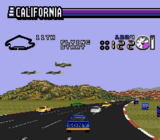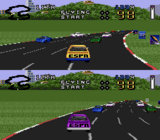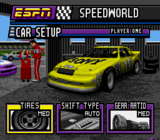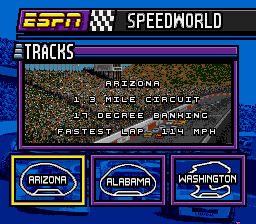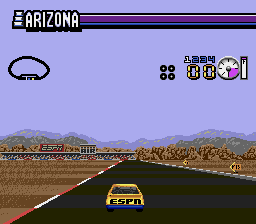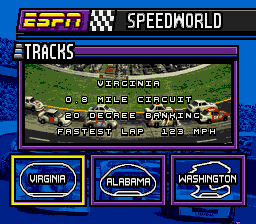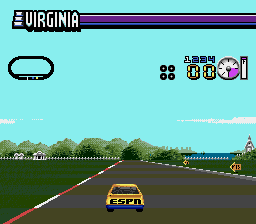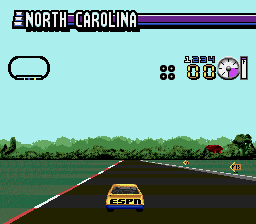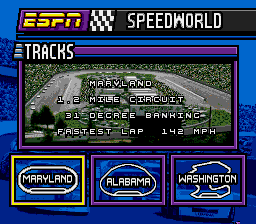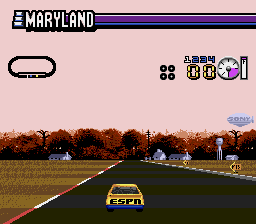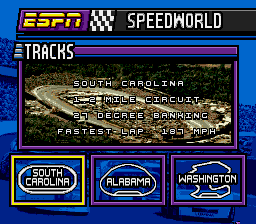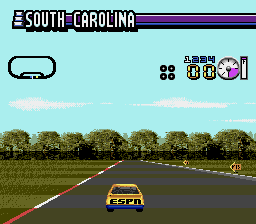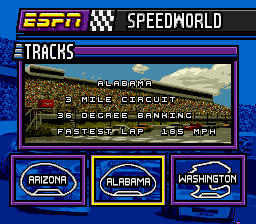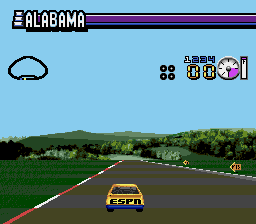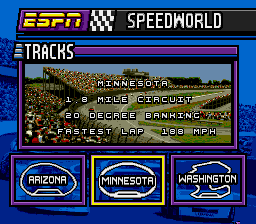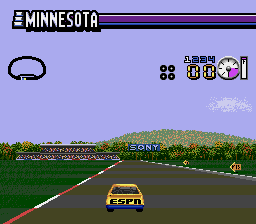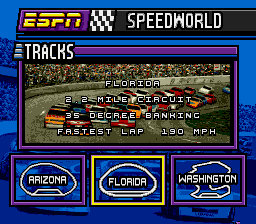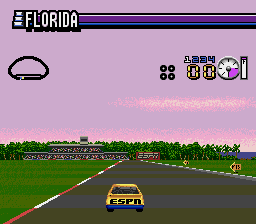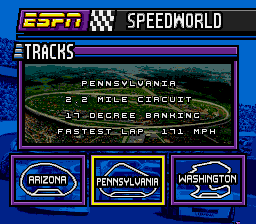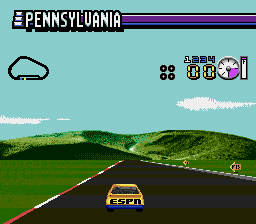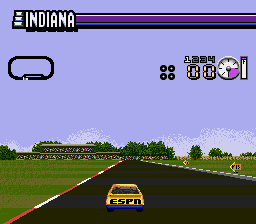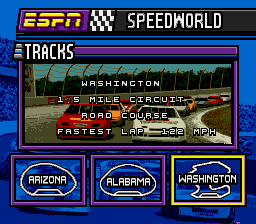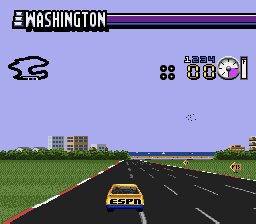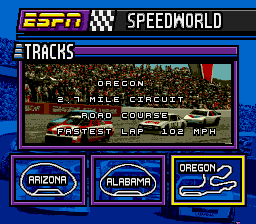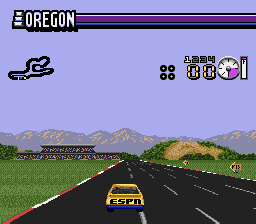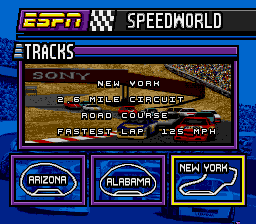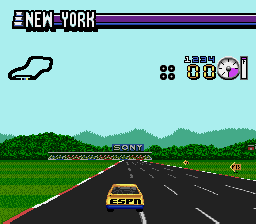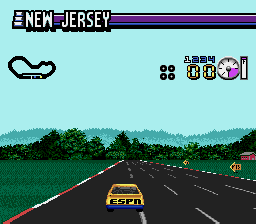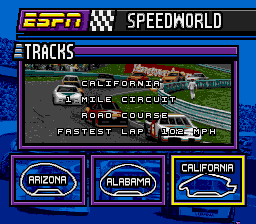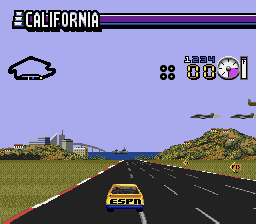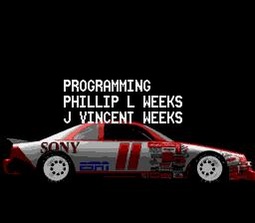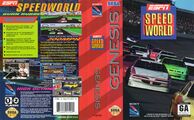ESPN Speedworld
From Sega Retro
| ESPN Speedworld | ||||||||||
|---|---|---|---|---|---|---|---|---|---|---|
| System(s): Sega Mega Drive | ||||||||||
| Publisher: Sony Imagesoft | ||||||||||
| Developer: Sony Imagesoft | ||||||||||
| Licensor: ESPN | ||||||||||
| Sound driver: GEMS | ||||||||||
| Genre: Racing | ||||||||||
| Number of players: 1-2 | ||||||||||
| ||||||||||
|
ESPN Speedworld is a third-person stock car racing game released for the Sega Mega Drive. It was exclusive to North America. It is named after the ESPN SpeedWorld program that aired on the American television channel ESPN and features sideline reporter Jerry Punch.
Contents
Gameplay
ESPN Speedworld is a 16-bit rendition of NASCAR, only without the NASCAR license. The objective is to race around a series of banked oval tracks and finish first. Races have 12 total competitors and begin with an automated flying start where every car does a pace lap. Races have no in-game music.
There are four control schemes. In every scheme, the car steers with ![]() and
and ![]() . Configuration #1 accelerates the vehicle with
. Configuration #1 accelerates the vehicle with ![]() , brakes with
, brakes with ![]() , upshifts with
, upshifts with ![]() , and downshifts with
, and downshifts with ![]() . Configuration #2 accelerates the vehicle with
. Configuration #2 accelerates the vehicle with ![]() , brakes with
, brakes with ![]() , upshifts with
, upshifts with ![]() , and downshifts with
, and downshifts with ![]() . Configuration #3 accelerates the vehicle with
. Configuration #3 accelerates the vehicle with ![]() , brakes with
, brakes with ![]() , upshifts with
, upshifts with ![]() , and downshifts with
, and downshifts with ![]() . Configuration #4 accelerates the vehicle with
. Configuration #4 accelerates the vehicle with ![]() , brakes with
, brakes with ![]() , upshifts with
, upshifts with ![]() , and downshifts with
, and downshifts with ![]() .
.
As in real stock car racing, the player can take advantage of drafting, which is the technique of driving close behind another car (going within 10 mph of the same speed) to exploit the low-pressure zone created by the lead car. This has the effect of reducing the effect of drag and increasing the speed of both cars. If the cars enter a turn while drafting, the tailing car can execute a slingshot pass by overtaking from the inside of the turn.
Races are long (a minimum of 10 laps each), and the player must make pit stops every so often to repair tire wear and refuel the car. Tire wear and fuel remaining are both indicated by gauges in the top-right of the screen. The player can make a pit stop by pulling into the pit area of the track and coming to a stop. While on a pit stop, the player can change the tires with ![]() or refuel the car with
or refuel the car with ![]() . Pressing the buttons rapidly completes the pit stop faster.
. Pressing the buttons rapidly completes the pit stop faster.
If the player fails to replace worn-out tires, they may blow-out, retiring the player from the race. The player can also be retired from the race from being involved in a bad wreck.
Modes
The game has multiple modes, which are chosen from the options menu:
- Single Race: A single-player mode where the player plays a single race on any track with computer-controlled competitors. The player can race a qualifying lap to determine the starting position or skip straight to the race (but starting in the last position).
- Head to Head: A two-player mode where the players play a single race on any track with computer-controlled competitors. Player can race a qualifying lap to determine the starting positions or skip straight to the race (with player one starting in 11th place and player two starting in 12th place).
- Practice: A single-player mode where the player plays a single race on any track with no competitors.
- Season: A single-player mode where the player plays a 15-race season on every track with computer-controlled competitors. The player is awarded 100 points for a 1st place finish, 50 for 2nd, 40 for 3rd, 25 for 4th, 20 for 5th, then 19 for 6th and one point fewer for every successive place. An additional point is awarded for every lap led (completed in 1st place). The top six positions are awarded money, which can be used to upgrade the player's car and pit crew. The amount of money awarded varies depending on the race. The winner of the season is the competitor with the most points at the end. There is a battery backup that stores the player's season progress.
There are three difficulty levels (Rookie, Pro, and Veteran). After choosing a track, there are options to toggle pit stops (which affects whether the car's tires wear out and fuel runs out), toggle damage (which affects if the car can be damaged from collisions), and choose the number of laps in each race (10, 20, 30, 40, or 50).
Car setup
Before each race, the player can set up the parts in the car. These choices have different trade-offs depending on how the player wants to race.
- Tires: Choose between soft, medium, or hard tires. Softer tires offer better handling but wear out faster, necessitating more pit stops.
- Shift Type: Choose between an automatic or a manual transmission. The manual transmission has four gears, with the lowest having the fastest acceleration but the highest having the highest top speed.
- Gear Ratio: Choose between low, medium, or high gearing. Lower gearing has the best acceleration but the lowest top speed.
- Suspension: Choose between normal, tight, or loose suspension tuning. Tighter suspension makes steering more sensitive.
- Paint: Choose between six different colors for the car.
- Spoiler: Choose between a 30-, 45-, or 60-degree angle for the spoiler. Higher spoiler angles increase the traction on the driven wheels but also impairs the car's top speed and fuel efficiency.
These additional choices are available in the Season mode. Each one can be upgraded up to six times; each upgrade costs money, which is won by winning races.
- Engine: Upgrading the engine improves the car's top speed and fuel efficiency.
- Pit Crew: Upgrading the pit crew increases their speed.
- Body: Upgrading the body improves the car's handling and fuel efficiency.
Tracks
There are 15 total tracks, most of which are based on NASCAR speedways.
| Arizona | |
|---|---|
|
Based on: Phoenix | |
| Virginia | |
|
Based on: Martinsville | |
| North Carolina | |
|
Based on: Rockingham | |
| Maryland | |
|
Based on: Dover | |
| South Carolina | |
|
Based on: Darlington | |
| Alabama | |
|
Based on: Talladega | |
| Minnesota | |
|
Based on: Michigan | |
| Florida | |
|
Based on: Daytona | |
| Pennsylvania | |
|
Based on: Pocono | |
| Indiana | |
|
Based on: Indianapolis | |
| Washington | |
| Oregon | |
|
Based on: Sears Point | |
| New York | |
|
Based on: Watkins Glen | |
| New Jersey | |
| California | |
Versions
ESPN Speedworld was released for the Mega Drive and Super NES at around the same time, and the two versions are very similar. The primary difference is that the SNES version has more on-screen colours and more interesting screen transitions (as opposed to the Mega Drive's fade to black). The technology used for drawing the tracks is identical (that is to say, "Mode 7" is not utilised on the SNES, as it is in Mario Kart and F-Zero).
The Mega Drive version's vehicles advertise Sega, ESPN, and Sony (Imagesoft), while all advertising was removed from the SNES version (which includes billboards at the side of the road).
Production credits
- Programming: Phillip L. Weeks, J. Vincent Weeks
- Design Team: Vincent Weeks, Phil Weeks, Bob Gordon, Mark Lyons, Christopher Whaley
- Background Art: Alesia Howard, Milo Cooper
- Animations: Joe Brisbois, Emmanuel Valdez, Ted Robertson, Dave Fenderson
- Additional Animations: Bert Huntsinger, John Scharman, Andy Jarros, Leonard McVicker, Alesia Howard
- Sound and Music: Rex Baca, Joe Hight
- Producers: Christopher Whaley, Daniel Meade
- Executive Producer: Rich Robinson
- Assistant Producer: Dennis Quinn
- Testers: Fred Wigand, Greg Kaine, Justin Busch, Martha Williams, Jody Kelsey, Andre Leighton
- Additional Testers: Bruce Cochrane, Seth Luisi, Jose Cruz, Tobin Russell
- Special Thanks to: Liz Weeks, John W. Weeks, Galles Racing, High Tech Only
- Executive Producers: Steve Bornstein, Ed Durso, Dick Glover, Tom Hagopian, Jim Noel, John Wildhack
- Special Thanks to: Jerry Punch
Magazine articles
- Main article: ESPN Speedworld/Magazine articles.
Promotional material
Physical scans
| Sega Retro Average | |||||||||||||||||||||||||||||||||||||||
|---|---|---|---|---|---|---|---|---|---|---|---|---|---|---|---|---|---|---|---|---|---|---|---|---|---|---|---|---|---|---|---|---|---|---|---|---|---|---|---|
|
| 35 | |
|---|---|
| Based on 7 reviews | |
Technical information
- Main article: ESPN Speedworld/Technical information.
References
- ↑ File:ESPN Speedworld MD credits.pdf
- ↑ EGM², "November 1994" (US; 1994-1x-xx), page 217
- ↑ 1700 igr dlya Sega, "" (RU; 2001-xx-xx), page 105
- ↑ Electronic Games (1992-1995), "March 1995" (US; 1995-0x-xx), page 63
- ↑ GamePro, "February 1995" (US; 199x-xx-xx), page 116
- ↑ Mega Fun, "02/95" (DE; 1995-01-18), page 104
- ↑ Play Time, "3/95" (DE; 1995-02-08), page 105
- ↑ Tricks 16 bit, "Tricks Sega Gold 800 igr" (RU; 1998-03-20), page 65
- ↑ VideoGames, "March 1995" (US; 1995-02-xx), page 83
| ESPN Speedworld | |
|---|---|
|
Main page | Magazine articles | Reception | Region coding | Technical information
Prototypes: 1994-07
| |

